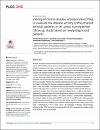| Abstract | Routine use of the Disease Activity Score-28 (DAS28) to assess the disease activity in rheumatoid arthritis (RA) is limited due to its dependency on laboratory investigations and the complex calculations involved. In contrast, the clinical disease activity index (CDAI) is simple to calculate, which makes the "treat to target" strategy for the management of RA more practical. We aimed to assess the validity of CDAI compared to DAS28 in RA patients in Sri Lanka. A total of 103 newly diagnosed RA patients were recruited, and their disease activity was calculated using DAS 28 and CDAI during the first visit to the clinic (0 months) and reassessed at 4 and 9 months of follow-up visits. The validity of the CDAI, compared to DAS 28, was evaluated. Patients had a female preponderance (6:1) and a short symptom duration (mean = 6.33 months). Internal consistency reliability of CDAI, as assessed by Cronbach’s α test, was 0.868. Convergent validity was assessed by correlation and Kappa statistics. Strong positive correlations were observed between CDAI and DAS 28 at the baseline (0 months), 4 and 9 months of evaluation (Spearman’s r = 0.935, 0.935, 0.910, respectively). Moderate-good inter-rater agreements between the DAS-28 and CDAI were observed (Weighted kappa of 0.660, 0.519, and 0.741 at 0, 4, and 9 months respectively). Discriminant validity, as assessed by ROC curves at 0, 4th, and 9th months of the evaluation, showed the area under the curve (AUC) of 0.958, 0.979, and 0.910, respectively. The suggested cut-off points for different CDAI disease activity categories according to ROC curves were ≤ 4 (Remission), > 4 to ≤ 6 (low), > 6 to ≤ 18 (moderate), > 18 (high). These findings indicate that the CDAI has good concordance with DAS 28 in assessing the disease activity in RA patients, in this study sample. |


